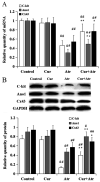Curcumin relieves mice gastric emptying dysfunction induced by L-arginine and atropine through interstitial cells of Cajal
- PMID: 33850520
- PMCID: PMC8027730
- DOI: 10.3892/etm.2021.9980
Curcumin relieves mice gastric emptying dysfunction induced by L-arginine and atropine through interstitial cells of Cajal
Abstract
Curcumin is natural polyphenol from Curcuma longa rhizomes with several biological properties. Our previous studies demonstrated that curcumin inhibited functional gastric emptying disorders induced by L-arginine, the precursor of nitric oxide (NO), and atropine, an acetylcholine receptor (AChR) blocker. However, the mechanism of action of curcumin remains unclear. In the present study, mouse models of functional gastric emptying disorders induced by L-arginine and atropine were used to examine changes in interstitial cells of Cajal (ICC) and NO- and ACh-mediated regulation of gastrointestinal motility. Curcumin pre-treatment ameliorated the gastric emptying rate in mice treated with L-arginine or atropine (P<0.01). NO content and NO synthase activity significantly increased in the stomachs of L-arginine-treated mice, compared with controls (P<0.01). Acetylcholinesterase activity (P<0.01) and mRNA expression (P<0.01), as well as AChR mRNA levels (P<0.05) significantly decreased following atropine treatment. Moreover, in both models, the levels of c-kit, anoctamin 1 and connexin 43 significantly decreased in the stomach (P<0.01). Conversely, curcumin pre-treatment inhibited the changes induced by L-arginine and atropine (P<0.01 or P<0.05). By affecting the production of exogenous NO, the effects of Ach-AchR and the biomarkers of ICC, curcumin relieves the gastric emptying dysfunction in mice.
Keywords: acetylcholine; atropine; curcumin; functional gastrointestinal disorders; nitric oxide.
Copyright © 2021, Spandidos Publications.
Conflict of interest statement
The authors declare that they have no competing interests.
Figures




Similar articles
-
Curcumin Alleviates the Side Effects of Cisplatin on Gastric Emptying of Mice by Inhibiting the Signal Changes of Acetylcholine and Interstitial Cells of Cajal.J Med Food. 2020 Sep;23(9):920-927. doi: 10.1089/jmf.2019.4599. Epub 2020 Aug 20. J Med Food. 2020. PMID: 32833554
-
Curcumin Alleviates the Functional Gastrointestinal Disorders of Mice In Vivo.J Med Food. 2017 Dec;20(12):1176-1183. doi: 10.1089/jmf.2017.3964. Epub 2017 Sep 7. J Med Food. 2017. PMID: 28880711
-
Effects of nitric oxide on antral motility and gastric emptying in humans.Eur J Gastroenterol Hepatol. 1995 Feb;7(2):97-102. Eur J Gastroenterol Hepatol. 1995. PMID: 7712314 Clinical Trial.
-
Curcumin improves expression of SCF/c-kit through attenuating oxidative stress and NF-κB activation in gastric tissues of diabetic gastroparesis rats.Diabetol Metab Syndr. 2013 Mar 1;5(1):12. doi: 10.1186/1758-5996-5-12. Diabetol Metab Syndr. 2013. PMID: 23448582 Free PMC article.
-
Delayed gastric emptying and disruption of the interstitial cells of Cajal network after gastric ischaemia and reperfusion.Neurogastroenterol Motil. 2010 May;22(5):585-93, e126. doi: 10.1111/j.1365-2982.2009.01444.x. Epub 2009 Dec 23. Neurogastroenterol Motil. 2010. PMID: 20040059
References
-
- Hussain Z, Thu HE, Amjad MW, Hussain F, Ahmed TA, Khan S. Exploring recent developments to improve antioxidant, anti-inflammatory and antimicrobial efficacy of curcumin: A review of new trends and future perspectives. Mater Sci Eng C. 2017;77:1316–1326. doi: 10.1016/j.msec.2017.03.226. - DOI - PubMed
-
- Yue GG, Kwok HF, Lee JK, Jiang L, Wong EC, Gao S, Wong HL, Li L, Chan KM, Leung PC, et al. Combined therapy using bevacizumab and turmeric ethanolic extract (with absorbable curcumin) exhibited beneficial efficacy in colon cancer mice. Pharmacol Res. 2016;111:43–57. doi: 10.1016/j.phrs.2016.05.025. - DOI - PubMed
LinkOut - more resources
Full Text Sources
Other Literature Sources
